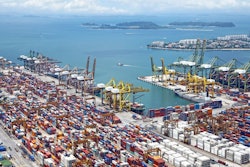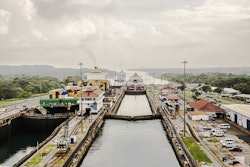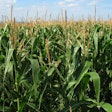Supply and demand forces determine the destinations and volumes of agricultural shipments. One such supply force shaping agricultural freight flows is the availability of different transportation modes.
Some Midwestern grain shippers have ready access to barge transportation, which costs less per ton-mile than rail. However, barge transportation is practical only for origins and destinations near rivers.
When barge is unavailable or too costly to access, many grain shippers ship by rail. As their distance to a navigable waterway increases, barge becomes more expensive to access, and shippers’ likelihood of choosing barge declines. Overall, barge and rail markets are closely related, but how they interact and compete in overlapping territory (e.g., within 300 miles of the inland waterway) is not well understood.
Sytsma and Wilson studied the conditions that led Midwest corn shippers to choose barge or rail. Using data from 2000 to 2017, the researchers measured how shippers’ preference for each mode changed as their distance to a waterway changed. The following highlights and describes the study’s main results.
Tonnages in Region Vary by Mode and Location
The researchers developed regional zones along the Mississippi River System to examine rail and barge flows of corn. Figure 1 depicts these barge regions with the points colored by region and sized by origination volumes of barged corn.3
In these zones, barge transported about 86 percent of the combined barge and rail annual tonnage. The Illinois zone was the most significant origin for both modes, originating 21 percent of tonnage for barge shipments and 46 percent for rail. The next three largest origination zones for barge were the Upper Mississippi (19 percent), Mid-Mississippi (18 percent), and St. Louis (18 percent). After Illinois, the next two largest origination zones for rail were the Lower Ohio (16 percent) and the Upper Mississippi (11 percent).
The vast majority of barged corn shipments terminated in the Central (Louisiana) Gulf (fig. 2 left-pane, p. 3), while rail flows showed more variation (fig. 2 right-pane, p. 3). On average, 28 percent of annual rail tonnage terminated in the Central Gulf; 25 percent, in the Lower Ohio area; 16 percent, in the Illinois River area; and 15 percent, in the Mid-Mississippi River area.
Modal Substitution: Preference for Barge Declines as Distance to Water Increases
Rail is the dominant mode for long-distance, land-based shipments of heavy commodities. Railroads’ ability to set price varies by location. More specifically, railroad pricing is constrained wherever shippers’ proximity to waterways gives them viable access to barge transportation.
To analyze shippers’ preference for barge versus rail in each river zone, the researchers studied shares of freight originations by mode at various distances from each waterway. In general, shippers preferred to ship by barge, which granted higher returns than rail, on average. However, preference for barge generally declined as distance to the waterway increased (and barge became more costly to access). Furthermore, as barge shipping conditions became less favorable—because of higher barge rates or longer distances to the waterway—shippers were more likely to ship by rail.
The preference for barge transportation was strongest for shippers nearest a navigable waterway, and the preference fell to zero for shippers beyond roughly 175 miles from the waterway.
Conclusions
The researchers analyzed rail and barge shipments of corn that originated and terminated within given distances of navigable Mississippi, Illinois, and Ohio waterways from 2000 to 2017.
Shippers close to a waterway overwhelmingly shipped by barge. However, as a shipper’s distance to the waterway increased, barge’s market share decreased and rail’s market share increased.
Given shippers’ tendency to substitute one mode for the other based on market conditions, trends in either market (rail or barge) will affect the supply-and-demand equilibrium of the other.
The description and findings contained in this article are drawn from recent USDA-sponsored research from Tobias Sytsma and Wesley Wilson. The full report and a brief summary are available online.
Contacts:
[email protected], [email protected], [email protected]

















